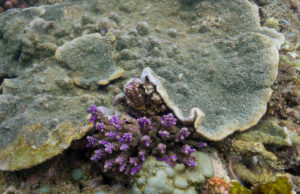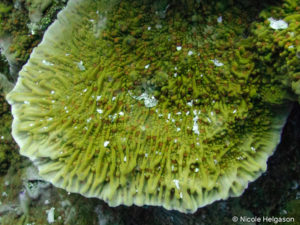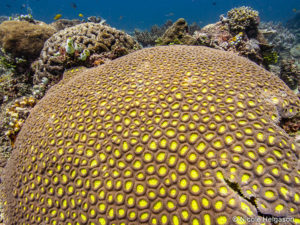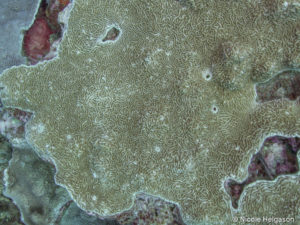In an ongoing series identifying Indo-Pacific coral species and growth forms, we’ve covered types including branching and plating. Today we’ll take a look at encrusting corals of the Indo-Pacific.
Corals are living animals seeking out life on the reef. Each coral is made from tiny animals called polyps, which build a hard calcium-carbonate shell around their body for protection. These hard skeletons grow together to become the coral reef. You will notice while diving, snorkeling, or just looking at pictures of a reef, that there are many different shapes, sizes, and forms.
If you’re new to coral identification in general, look at our “Coral Biology: Part I” and “Coral Biology: Part II” articles. These will help you learn the basics of coral biology, as well as some helpful terms for identification. And if you’re new to Indo-Pacific coral identification, check out our “Introduction to Hard Corals of the Indo-Pacific.”
Encrusting corals of the Indo-Pacific

The corals that divers most easily overlook are the encrusting species. These corals creep along the rocks, holding everything together like a layer of cement fusing together the substrate. It’s not until you take a closer look, down to the polyp level, that you start to notice just how brilliant and intricate these corals can be.
Encrusting corals can tolerate high-flow environments much more than any other coral growth form. You can find encrusting corals in nearly every underwater habitat; however, you will find the hardier varieties dominate reef walls that are prone to swift currents.
Encrusting corals can have “thick” crusts, less than ¼ inch (.63 cm) thick, or layers thinner than one millimeter. Usually the thickest part of the coral lies in the center of the colony, with the thinnest crust at the growing edge of the coral. Layer by layer, encrusting species grow toward the light and away from predators. Many encrusting corals will also start having a plating form once they reach the edge of a rock or substrate, even if they start off as encrusting.
Up-close observation of these encrusting corals reveals tiny polyps and either short walls or rounded corallites. It’s a treat to find encrusting corals with two, three or even four different colors. This lime-green Montipora with little orange polyps clung to a wall in Bunaken National Park in Sulawesi, Indonesia.
Once you learn to recognize the signs of an encrusting coral, you can learn to identify the different genus groups and species. Here are five genera of coral you can easily identify while diving in the Indo-Pacific.
Montipora

Montipora is one of the most abundant corals, with over 50 species in the Indo-Pacific. Montipora can be branching, encrusting, or form thin plates. Recognize this genus via the small corallites that are embedded in the surface of the coral. You’ll often find them between ridges, although they lack a distinct corallite wall. This coral comes in a variety of colors and the rarest have three or more colors in the same coral.
Cyphastrea

Cyphastrea is a true encrusting coral, with only one species known to have a branching form. Recognize Cyphastrea via the round cone or tube-shaped corallites covering the surface of the colony. Importantly, notice that each corallite has its own walls with gaps or space between each new corallite. There are around 10 species of Cyphastrea.
Favia

Favia are a diverse group of corals that can be encrusting especially when they are small, becoming massive domes or boulders as they grow. Common Favia colors are green, yellow and brown, but can also feature a mix of colors like orange, blue, and red. Identify a Favia coral by noting that it has distinct corallite walls.
Favites

Favites is a lookalike coral that one can easily confuse with the Favia genus. With a little practice, you can tell these two apart by looking at the corallite. The Favites coral features fused corallite walls. This can be easier to see at night one the tissue is retracted and feeding tentacles are out. Favites coral walls are also more polygonal and unevenly shaped compared to the rounded, smooth Favia corallites.
Pachyseris

Pachyseris has narrow ridges a few millimeters above the surface of the colony. The ridges can be long and narrow or short and contorted. There are five species of this coral, which can be plating, encrusting or branching. This coral lacks corallite structures and instead features septa-costea, which run perpendicular to the narrow ridges.

